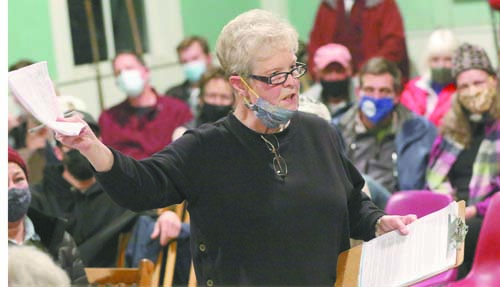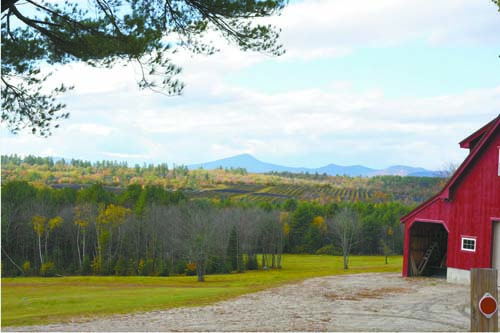Shedding some light on Lovell solar project

By Wayne E. Rivet
Staff Writer
LOVELL — Every morning when Lynn Hurd wakes up, she sees a beautiful mountain range and wooded area below it from her farmhouse on Christian Hill in Lovell.
“I see it in the wintertime covered in white from the snow. I see the trees bud in the spring and open up to fill with leaves, and I see the vibrant foliage in the fall. I appreciate and enjoy this natural beauty every day,” she told a packed Town Hall last Wednesday night. “…At present, the talk is that I will look down toward the mountains and woods below onto 110 acres across the road only to see a huge section of woods removed and an enormous mass of solar panels and whatever apparatus is involved in its place.”
Walden Solar, a subsidiary of Walden Renewables Development LLC of Portsmouth, N.H. and New York, is proposing to develop two solar arrays on about 180 acres between Christian Hill Road and Shave Hill Road.
Hurd and other “concerned” residents packed the Town Hall at a regularly-scheduled Planning Board meeting, seeking both answers about the two-field array and supporting a push for a moratorium on solar development.
Hurd, who read from a prepared statement, impressed upon planners the need to protect Christian and Shave Hill Roads, which are popular stopping points to view scenic vistas.

“Over the years, at any time, particularly during the summer and fall, I have seen hundreds and hundreds of vehicles come down the hill near my house (which her parents purchased in 1944) and slow down, pull over, or just even stop in the road to observe the view of the mountains and trees below. Many of them will take pictures. I am not sure any of you know how much traffic goes over both Christian and Shave Hill Roads. It is constant during the warmer months,” she said. “It isn’t only the fact of desecrating Christian Hill, which is not an aesthetical place to carry out this project. We are all deeply concerned about our property values in Lovell. Who is going to want to move here if our property values go down the tubes? We have all worked hard and don’t want to take a chance of that to happen while some pad their pockets and the rest of us will pay with value loss.”
Like several people voiced during the meeting, Hurd questioned how the project has been kept under wraps until developers presented the application in at planners’ November meeting.
“The fact that this was all done so underhandedly is very disturbing. I still have not received any notification of any kind to date. This should have been opened up to the town and not have left anyone in the dark. An enormous amount of people are affected – residents, non-residents, and visitors,” she said. “Kezar Lake and our scenic areas have been a draw to Lovell for many, many years. There are other places suitable for this – but not in such a peaceful, scenic vicinity for everyone to see. This is a residential zone – not commercial or industrial, and should nothave even been a consideration!”
Dale Knapp, a professional consultant at Biodiversity Research Institute in Portland, explained Walden initially spent time with Lovell Code Enforcement Officer Alan Broyer regarding how the proposed project would fall under the town’s existing regulations. Lovell has no solar ordinance nor is there language within site plan standards that specifically mention “solar.”
However, Knapp pointed that the project meets the definition of two existing terms — one, it meets the definition of “essential service (an electrical facility) and two, the Land Use table has the term “telecommunication facility,” which would allow for solar panels in the Rural District. Thus, Walden applied for a conditional use permit from the Planning Board.

“The use category of Telecommunications Facilities makes sense for permitting purposes, as the Project will create similarly low land use intensity, traffic impacts, public services impacts, and environmental impacts.”
“We’ve read the ordinance and believe it fits under existing rules,” Knapp added.
Planning Board chairman Heinrich Wurm pointed out to the large crowd that the town ran into a similar problem when it received an application for a self-storage facility off Route 5. Planners, Wurm said, applied a “similar” term — warehouse.
Knapp added that he spoke with Broyer regarding additional information planners and residents would like want to know when the application landed on the CEO’s desk.
“We’re not trying to back door you,” he said. “We are following a process.”
Project information has been posted on the town’s website.
Knapp outlined how Walden ultimately set its sights on Lovell.
“We look at the entire region,” Knapp noted. “We look to see if there is a willingness of landowners to lease property and what the proximity the site(s) is to established CMP lines and substations,” he said.
If approved, Walden expects to start construction by 2023, and generating power to the local grid by 2024.
Is this a done deal?
Several people voiced frustration and contempt regarding the lack of notice that a major solar array could be developed in Lovell.
Knapp insisted Walden, which has developed solar arrays across the state and New England, has followed proper steps. The process calls for once planners deem the application complete, a public hearing is scheduled and formal notification goes out to abutters.
Jack Pemberly of Walden Renewables guaranteed that “this is going to be a very public process” and “materials will be made available to the public.”
CEO Broyer noted, “I can’t legally talk about it to the public until it becomes a public document. Don’t think the town of Lovell is trying to back door you.”
“It’s a perception,” one resident responded.
Resident Colin Micklon came across a surveyor near his mother’s home and asked what he was up to. The surveyor claimed to be “just taking reference points.”
“I didn’t know if it was in regards to Google Earth or what it was. As far as I am concerned, everything was really quiet and deceitful from the start,” Micklon said.
Wurm could see both sides on whether keeping matters quiet over early notice was the best path to take.
“There is a certain amount of quiet that needs to be kept, but I’m not sure whether the company did the right thing the way they approached it,” he said. “They did an amazing amount of work, and I understand they didn’t want to come to us without having the data first.”

All about the view
Walden’s project is a big one. Applicants dispelled one person’s claim it would be the largest in Maine, but agreed it is bigger than the array being developed in Fryeburg (off Route 302, across the street from Froagies).
The application contains 600 pages.
When Wurm asked for comments by fellow board members regarding the project, the word “overwhelming” was used to describe the magnitude of information.
“Our job is to follow the ordinance, and figure out how this applies to the ordinance. I understand there is a huge amount of interest. I totally get the concern. There is a lot for us to push through with this,” planner Eugene Jordan said. “This is still preliminary, not a done deal. It’s still very early in the game.”
Planner Kevin McDonald echoed that sentiment, “This is a lot to chew on. We are working through the process and trying to do the best we can. I’m asking you all to just bear with us. Nothing has been decided. We’re in the initial stages of this and I’m not sure where it will go. It’s just a lot for me to understand. This is a huge project. If you take a ride over to Froagies in Fryeburg and see what is going on there, I guess this one is even bigger.”
The applicant team opened their presentation by showing scenic simulations from four viewpoints — three from Christian Hill Road (which is listed in the town’s Comprehensive Plan as one of seven scenic views in Lovell) and one from nearby Sabattus Mountain.
Steve Thompson explained the visual analysis process, which included identifying scenic resources (such as vistas, summits and historical sites), evaluating those resources and determining the “visual impact.”
A three-mile radius from the project site was used, with Thompson said “captures everything we need to look at.” He later informed the crowd that the visual points used were publicly accessible, and did not include views from private property.
When one simulation was shown, illustrating what the view would look like looking west, the property owner was perturbed that the company had not received his permission to photograph. Thompson said the photo was taken from the public way. The project array would be about 2,200 feet from the location shown. “It will be visible through gaps between vegetation and structures,” the report said.
Another view came from a “pull-off area” with views of western mountain ranges. It was 3,000 feet from the southern array. “Heavily screened by nearby foreground vegetation…Northern array not visible from this location.”
View 3 was 1,600 feet away from the northern array, “which will be visible.” Developers later said 70 to 75 percent of the array will be visible from this point.
While Thompson said motorists would only see the arrays for a few seconds, depending on travel speed, residents noted that many people walk those roads and certainly their visual would be much longer.
“Our professional opinion is this project will not unreasonably, adversely impact the scenic resources of the town of Lovell,” Thompson concluded.
Although the arrays pose no barrier to seeing the mountain ranges, one resident said, “When you are standing here looking at the door top, do you happen to see a couple of hundred people in this room as well?”
“Yes, I do,” Thompson answered.
“Exactly, that to me is a view. A view is not from the waist up. A view is what your eyes show you. The view is going to be impacted. Not just a little bit, but the entire view,” the citizen said. “You keep seeing the view of the mountaintop…that’s the cherry on top. The view is the view.”
Call for a moratorium
One resident suggested that one way to put the brakes on the project, since it has yet to be ruled as a completed application, is to put a 180-day moratorium in place — thus giving Lovell time to address its ordinance.
“Developers making an end run in towns that have no ordinances in place and loosely organized PB that meets occasionally,” one citizen said. “We need a moratorium so we can plan our town, and not have developers plan it for us.”
To pass a moratorium, planners would need to approve the measure, send it to selectmen, and if that board approves it, then a special town meeting is called for voters to act.
Wurm felts planners could also amend the existing ordinance to address terminology without enacting a moratorium.
The moratorium idea was rejected 3-2 (Wurm, McDonald and Jordan against; Jane Lansing and Diane Caracciolo for).
While several voiced support for “green energy” development, they also shared Lynn Hurd’s position, “I do believe we need alternate energy in our world, but this is not the place for it.”
Planners will take up the application at their Jan. 5 meeting.

